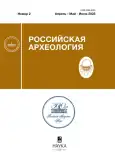Pot-shaped tiles of the 15th–16th centuries from excavations in Smolensk
- Autores: Krenke N.A.1,2, Ershov I.N.3, Raeva V.A.3, Stolyarova T.V.4
-
Afiliações:
- Institute for the History of Material Culture of the RAS
- Institute of Geography of the RAS
- Institute of Archaeology of the RAS
- Smolensk State Museum-Reserve
- Edição: Nº 2 (2025)
- Páginas: 157-163
- Seção: TO THE 80TH ANNIVERSARY OF A.V. CHERNETSOV
- URL: https://rjsvd.com/0869-6063/article/view/687987
- DOI: https://doi.org/10.31857/S0869606325020111
- EDN: https://elibrary.ru/IQZGBG
- ID: 687987
Citar
Texto integral
Resumo
The article discusses finds of pot-shaped tiles in the territory of Smolensk from the 1970s to the present. It is established that Smolensk tiles have similarities in both lines of pot-shaped tile evolution traced through the finds in Belarusian castles; the two lines originating from the common root. The period of existence of such tiles is determined within the 15th–16th centuries AD. It is assumed that Smolensk was part of the distribution zone of this product type. The authors also suggest that pot-shaped tiles characteristic of spreading Western «stove fashions» can serve as an important cultural marker distinguishing the material world of the Grand Duchy of Lithuania from its eastern neighbour.
Palavras-chave
Texto integral
Sobre autores
N. Krenke
Institute for the History of Material Culture of the RAS; Institute of Geography of the RAS
Autor responsável pela correspondência
Email: nkrenke@mail.ru
Rússia, Saint Petersburg; Moscow
I. Ershov
Institute of Archaeology of the RAS
Email: ershovin@yandex.ru
Rússia, Moscow
V. Raeva
Email: veraraeva@mail.ru
Independent Researcher
Rússia, MoscowT. Stolyarova
Smolensk State Museum-Reserve
Email: anasazi03@inbox.ru
Rússia, Smolensk
Bibliografia
- Ambrosiani S., 1910. Zur Typologie der Älteren Kacheln. Stockholm. 143 p.
- Asmolkova T.A. Otchet o provedenii kompleksa naturnykh okhrannykh arkheologicheskikh rabot, svyazannykh s rekonstruktsiey zhilogo doma, raspolozhennogo po adresu: g. Smolensk, ul. Malo-Shkol'naya, d. 6 v 2011 g. [Report on the implementation of a set of on-site archaeological conservation works related to the reconstruction of a residential building at the address: 6 Malo-Shkolnaya Street, Smolensk, in 2011]. Arkhiv Instituta arkheologii Rossiyskoy akademii nauk [Archive of the Institute of Archaeology RAS], R-1, № 29208, 29209.
- Baranova S.I., 2016. On the origin of Moscow medieval tiles. Vestnik Tomskogo gosudarstvennogo universiteta. Istoriya [Bulletin of Tomsk State University. History], 4 (42), pp. 53–60. (In Russ.)
- Hallenkamp-Lumpe J., 2006. Studien zur Ofenkeramik des 12. bis 17. Jahrhunderts anhand von Bodenfunden aus Westfalen-Lippe. Mainz: Verlag Philipp von Zabern. 460 p. (Denkmalpflege und Forschung in Westfalen, 42).
- Katalynas K., 2015. Vilniaus kokliai XV–XVII amžiuje. Vilnius: Lietuvos nacionalinis muziejus. 408 p.
- Krenke N.A., Ershov I.N., Ganichev K.A., Raeva V.A., 2021. Lithuanian Smolensk according to archaeological evidence. Rus' v XIII–XV vv. Novye otkrytiya v oblasti arkheologii i istorii [Rus in the 13th–15th centuries. New discoveries in archaeology and history]. Moscow: Indrik, pp. 277–284. (In Russ.)
- Krenke N.A., Khvorostova E.L., 2023. Roofing tiles and finger grooved bricks (palchatka) from excavations in Smolensk in 2022. Moskovskaya Rus': arkheologiya, istoriya arkhitektura [Moscow State: archaeology, history, architecture]. Moscow: Institut arkheologii Rossiyskoy akademii nauk, pp. 253–266. (In Russ.)
- Kushnerevich A.N., 2003. Gothic tiles of the Grand Duchy of Lithuania in the 14th–15th centuries AD. Arkhitekturno-arkheologicheskiy seminar. Iz istorii stroitel'noy keramiki srednevekovoy Vostochnoy Evropy [Architectural and archaeological seminar. From the history of construction ceramics of medieval Eastern Europe]. St. Petersburg: Izdatel'stvo Gosudarstvennogo Ermitazha, pp. 138–149. (In Russ.)
- Nabažaitė R., 2014. The late medieval vessel stove tiles in the topographical context of Klaipeda. Estonian Journal of Archaeology, 18, 2, pp. 102–115.
- Niemiec D., Olbrot J., 2022. Gotyckie i Renesansowe oraz manierystyczne kafle piecowe z wystroju pieców grzewczych klasztoru Dominikanów w Krakowie. Rocznik Krakowski, LXXXVIII, pp. 309–360.
- Nigmatullin R.A. Otchet o raskopkakh v g. Smolenske, ul. Metallistov, 8 v 1999 g. [Report on excavations in Smolensk, 8 Metallistov Street, in 1999]. Arkhiv Instituta arkheologii Rossiyskoy akademii nauk [Archive of the Institute of Archaeology RAS], R-1, № 22807, 22808, 22809.
- Prokhorov V.A., 2017. Notes on the topography of Smolensk (1st half of the 17th century): hills in Smolensk. Kray Smolenskiy [The Smolensk land], 1, pp. 15–18. (In Russ.)
- Pronin G.N., Sobol' V.E., 2013. Smolenskie izraztsy XVI–XIX vv. [Smolensk tiles of the 16th–19th centuries]. Smolensk: Svitok. 240 p.
- Roth Heege E. et al., 2012. Ofenkeramik und Kachelofen: Typologie, Terminologie und Rekonstruktion im deutschsprachigen Raum (CH, D, A, FL) mit einem Glossar in siebzehn Sprachen. Basel: Schweizerischer Burgenverein. 432 p.
- Sergina T.V., 2004. Smolensk ceramics of the middle of the 13th–17th century. Smolenskie drevnosti [Smolensk antiquities], 3. F.E. Modestov, ed. Smolensk, pp. 5–190. (In Russ.)
- Trusov O.A., 1988. Pamyatniki monumental'nogo zodchestva Belorussii XI–XVII vv. Arkhitekturno-arkheologicheskiy analiz [Sites of monumental architecture of Belarus from the 11th–17th centuries. Architectural and archaeological analysis]. Minsk: Nauka i tekhnika. 160 p.
Arquivos suplementares
















